The Eye metaspace[1] — the physical eye, the I, and the third eye — the feminine, lunar polarity of the installation sited at the city centre, is an energetic eye-shaped volumetric area determined by half-squaring a circle of the same width of one face of the staged Matrix in the Cave masculine polarity at the city periphery.
The Eye has an omega[2]-shaped entrance/exit facing west, opposite to the Cave entrance; a silver floor and a golden ceiling with a chromatic vortex in its middle, paralleled by the multicoloured cavea performing area in the Cave venue.
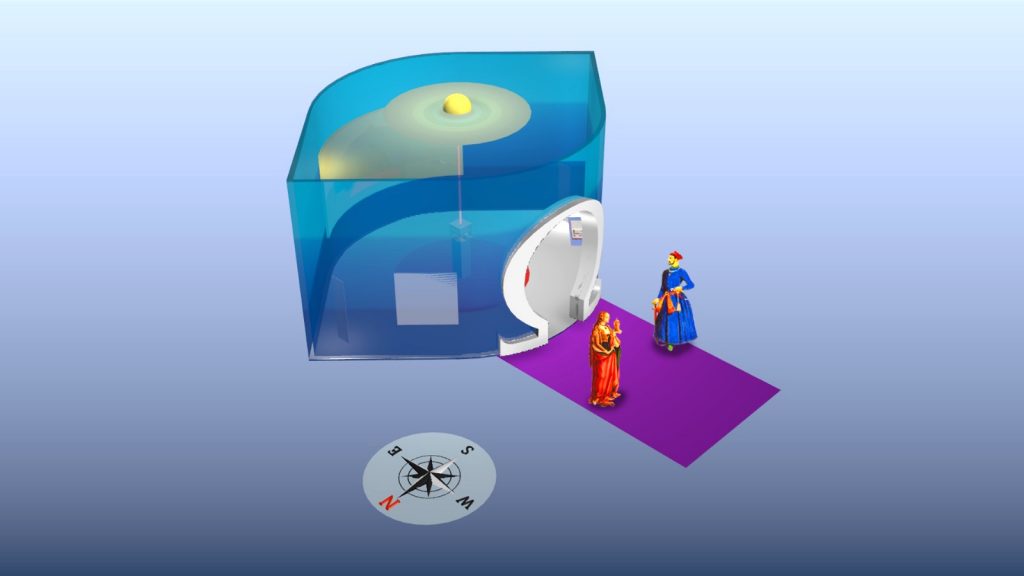
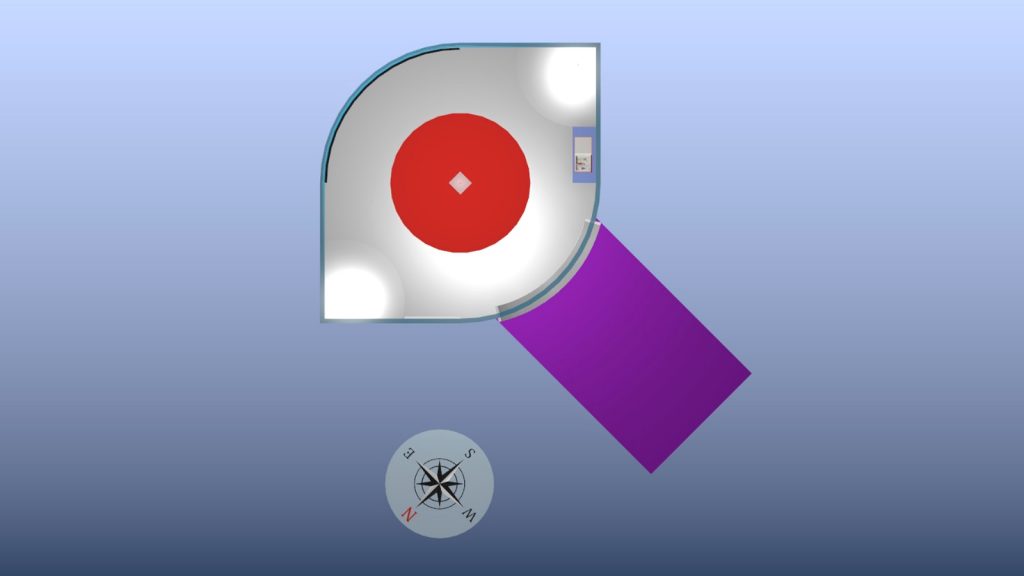
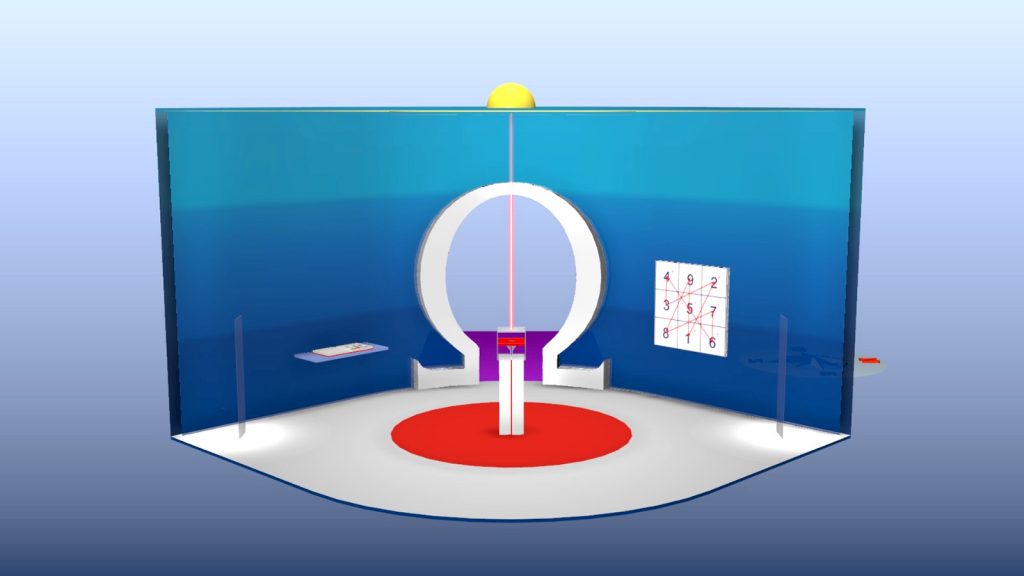
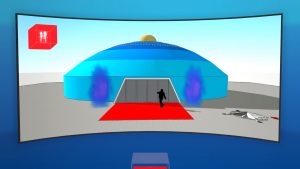
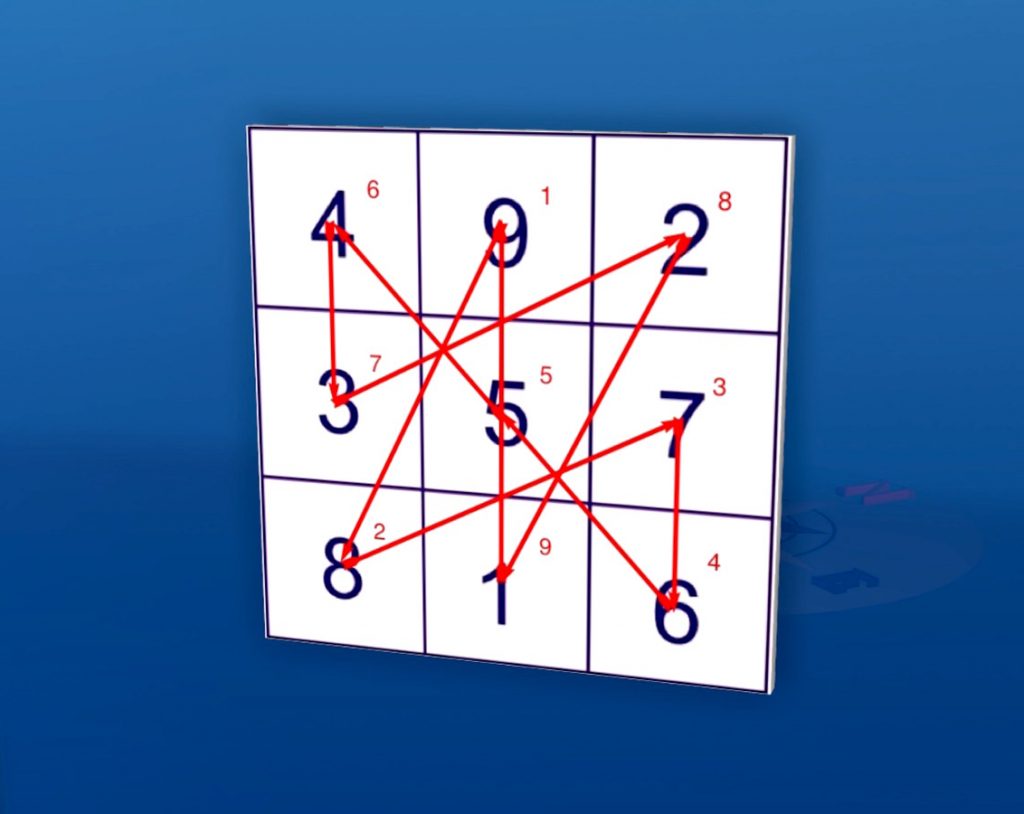 The metaspace is equipped with a sound-video system: on the upper eyelid wall, a screen livestreams, synchronically, the Cave 3.0 opera while is being performed in the Cave; on the facing lower eyelid wall at the right side of the omega-exit, a Magic Square screens the opera diachronically, anti-clockwise in each of its 15 quadrants, each delayed by 1 sec. shaping up a retrograde stream of the performance. The two screens are in dialogical mode, acting as eyelids, opening up or shutting down to vision while meeting their sights in the centre-space, where, on the red iris[3] on the silver floor, in the pupil[4], on a white rectangular plinth with red flows at each vertical side, rests the Matrix cubic exoskeleton in clear acrylic glass. On its middle plane of reflection, the first copy of the artist’s book Meetings with Remarkable Women, the Red Book, a semi-epistolary at the juncture of different systems of representation unfolding the interplay of the polarities protagonist of the narrative, the Royal Couple, within the 7 dimensions of the feminine soul. From the centre of the reversed cavea chromatic vortex on the ceiling, a red laser beam signalling the axis mundi uniting the Heaven and Earth polarities, points down to the golden heart on the cover of the Red Book, rippling down in red flows along the four side of the plinth to finally confluence into the floor and shape up the red iris.
The metaspace is equipped with a sound-video system: on the upper eyelid wall, a screen livestreams, synchronically, the Cave 3.0 opera while is being performed in the Cave; on the facing lower eyelid wall at the right side of the omega-exit, a Magic Square screens the opera diachronically, anti-clockwise in each of its 15 quadrants, each delayed by 1 sec. shaping up a retrograde stream of the performance. The two screens are in dialogical mode, acting as eyelids, opening up or shutting down to vision while meeting their sights in the centre-space, where, on the red iris[3] on the silver floor, in the pupil[4], on a white rectangular plinth with red flows at each vertical side, rests the Matrix cubic exoskeleton in clear acrylic glass. On its middle plane of reflection, the first copy of the artist’s book Meetings with Remarkable Women, the Red Book, a semi-epistolary at the juncture of different systems of representation unfolding the interplay of the polarities protagonist of the narrative, the Royal Couple, within the 7 dimensions of the feminine soul. From the centre of the reversed cavea chromatic vortex on the ceiling, a red laser beam signalling the axis mundi uniting the Heaven and Earth polarities, points down to the golden heart on the cover of the Red Book, rippling down in red flows along the four side of the plinth to finally confluence into the floor and shape up the red iris.
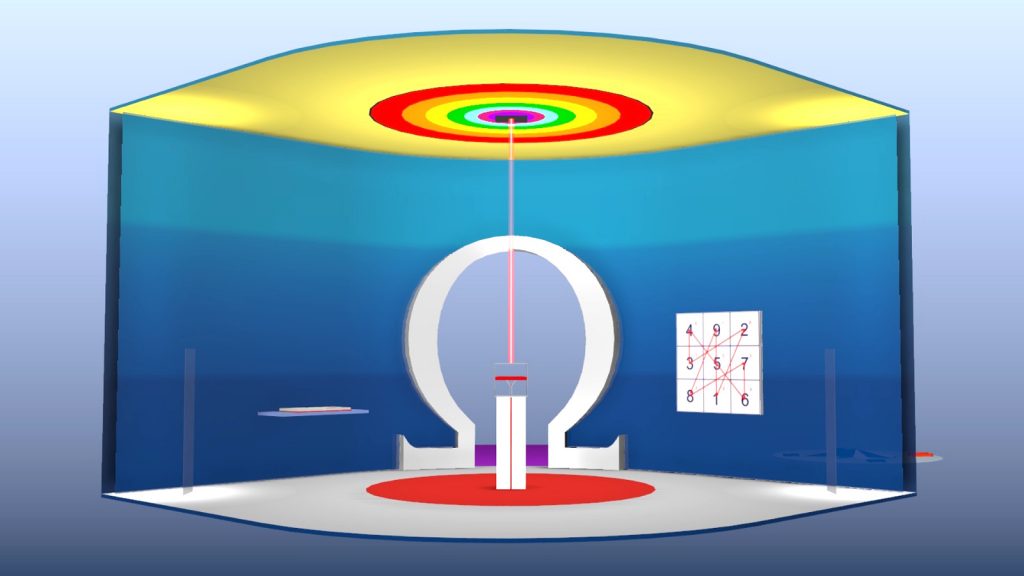
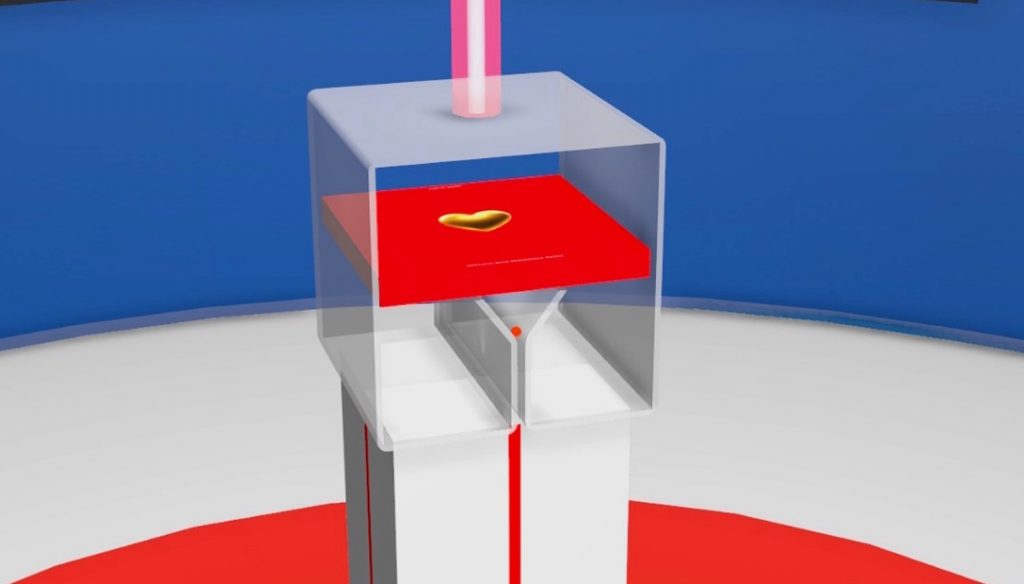
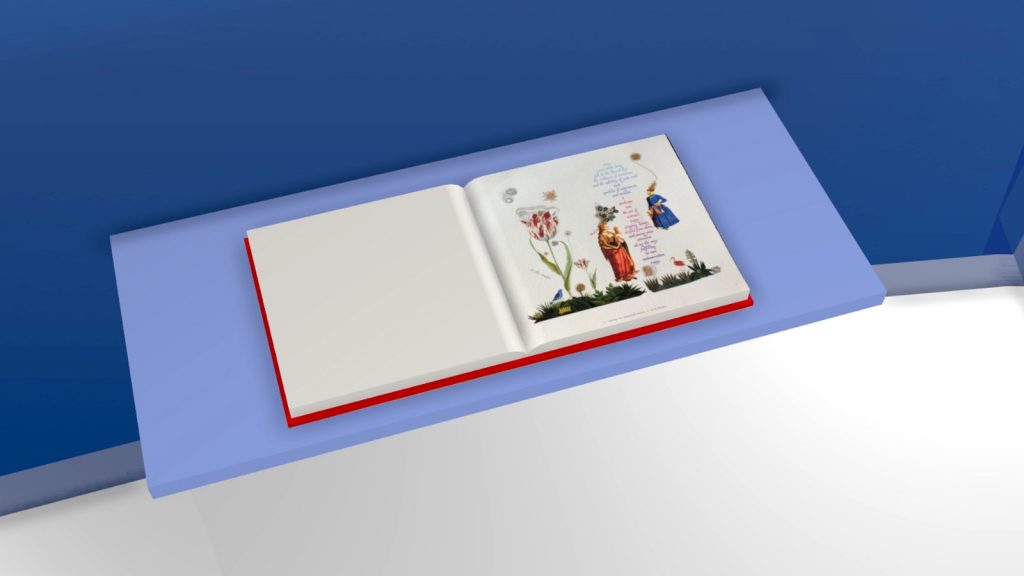
At each end of the palpebral commissures[5] where corners converge, a standing Guardian of the Threshold cast in clear acrylic glass silhouettes as the Matrix, gendered, crowned in golden and silver inlays. At the left of the exit, a shelf juts out from the wall to holds a copy of the Red Book opened at the Lectori Benevolo page depicting the Royal Couple in costume[6], paralleled and embodied in its four-dimensional expression by the two actors in costume on the violet carpet outside the Eye.
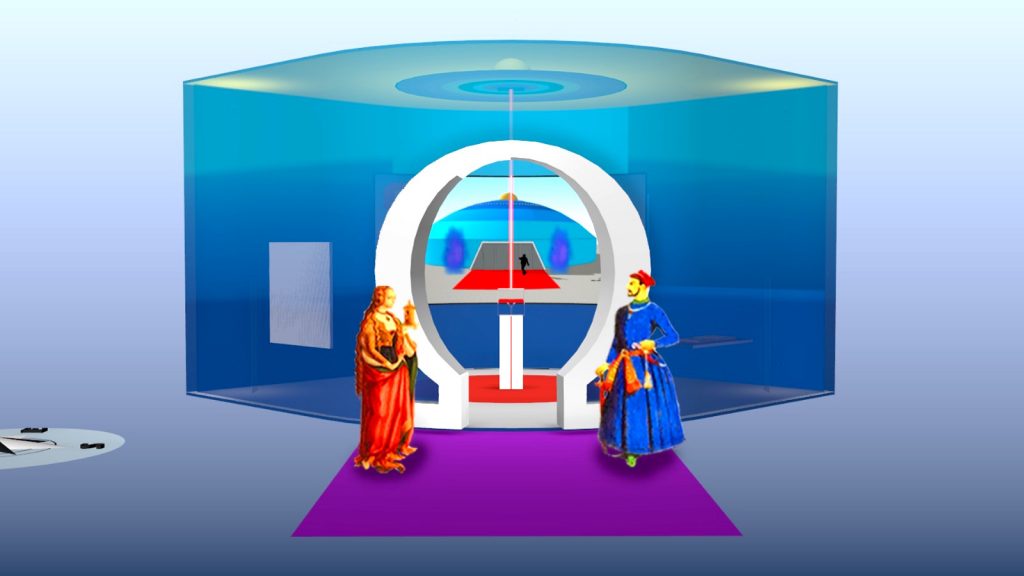
Simulation by Kristian Cardiello.
[2] Omega (capital: Ω, lowercase: ω; Greek ὦ, later ὦ μέγα, Modern Greek ωμέγα) is the 24th and last letter of the Greek alphabet. In the Greek numeric system/Isopsephy (Gematria), it has a value of 800. The word literally means “great O” (ō mega, mega meaning “great”), as opposed to Ο ο omicron, which means “little O” (o mikron, micron meaning “little”). The first use of the Omega sign dates back to the late 7th century BC. It was commonly used in Asia Minor region to denote the long half-open [ɔ]. Other variants of the broken omicron (Ο) with edges facing different directions were used in the Aegean islands of Thasos, Paros, and Melos, as well as the Dorian city of Knidos. With time, it became popular across the globe and is currently used in various fields and contexts. In eschatology, it denotes the end of something, or the last/final/ultimate limit of it, and represents a time of destruction, change and rebirth. Within the context of Christian belief, it forms a part of ‘Alpha and Omega’ representing an appellation of Jesus as the beginning and the end of all things. It also symbolises something great or the end of an increment of large development, could it be the universe, the planet, a country or an individual. In scientific field it takes up a variety of connotations, among others, in astrology, it represents the lunar nodes; in chemistry, the stable natural oxygen isotope oxygen-18; in physics, the unit ohm of electrical resistance; in cosmology it refers to the density of the universe; in statistical mechanics, to the number of microstates in a system; in computer science and mathematics, the constant in Lambert’s W function; in mathematics, the first uncountable and transfinite ordinal number in set theory; in ethology, is the lowest-ranking member in a pack. Being one of the most common ancient symbols, the Omega is commonly used in branding today.
[3] In ancient Greek, the word iris means “eye of heaven”. In Greek mythology, the goddess Iris (Ἴρις) is the personification of the rainbow, believed to be her dress, and the messenger of the gods. Like the rainbow is a bridge to the sky, so Iris took orders from Zeus and the other deities from the “eye of heaven” and, sliding down the curve of the rainbow, appeared in human form in front of the people to revel them the Heavenly orders. She travels with the speed of wind from one end of the world to the other, into the depths of the ocean and in the underworld. According to a myth, Iris mated with Zephyr and created Eros, the winged god of love.
[4] Pupil, the centre of the eye, from Latin pupilla, originally “little girl-doll,” diminutive of pupa (girl; doll) so called from the tiny image one sees of oneself reflected in the eye of another person. Greek used the same word, kore (girl), to mean both “doll” and “pupil of the eye”. According to Plato, “self-knowledge can be obtained only by looking into the mind and virtue of the soul, which is the diviner part of a man, as we see our own image in another’s eye.” [‘Alcibiades’, I.133].
[5] The palpebral commissure (Canthus, pl. canthi) is either corner of the eye where the upper and lower eyelids meet. The inner and outer canthi are, respectively, the medial and lateral ends/angles of the palpebral fissure. The lateral palpebral commissure (commissura palpebrarum lateralis; external canthus) is more acute than the medial, and the eyelids here lie in close contact with the bulb of the eye. The bicanthal plane is the transversal plane linking both canthi and defines the upper boundary of the midface.
[6] Mary Magdalene, Carlo Crivelli, ca. 1485; and The Imperial Guard, Heinrich Carl Wilhelm Berghaus, Die Völker des Erdballs nach ihrer Abstammung und Verwandtschaft, und ihren Eigenthümlichkeiten in Regierungsform, Religion, Sitte und Tracht … Mit … colorirten Abbildungen, 1845: 964, in Meetings with Remarkable Women, Excerpted Guests, page xxii.